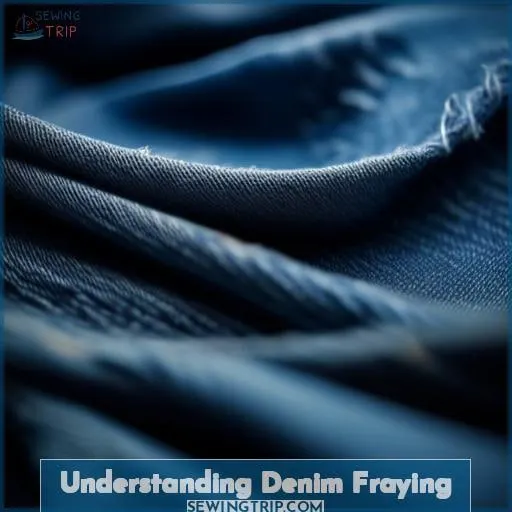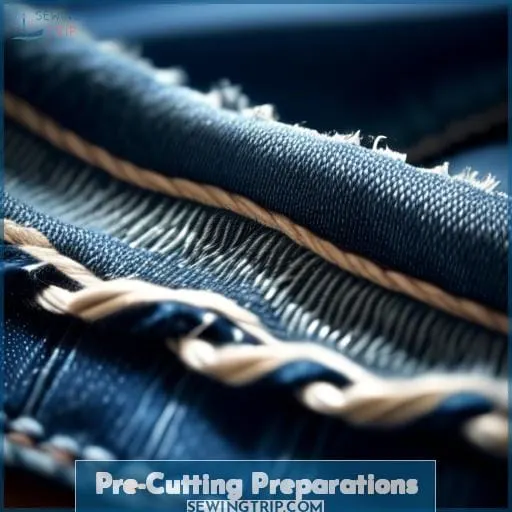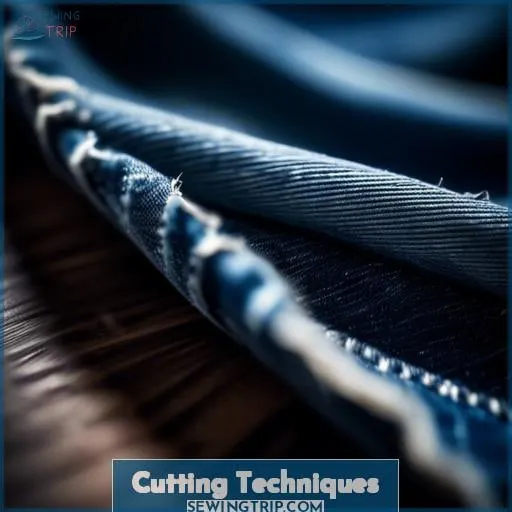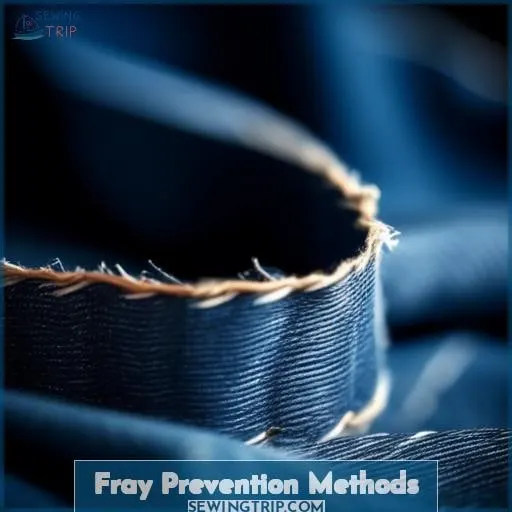This site is supported by our readers. We may earn a commission, at no cost to you, if you purchase through links.
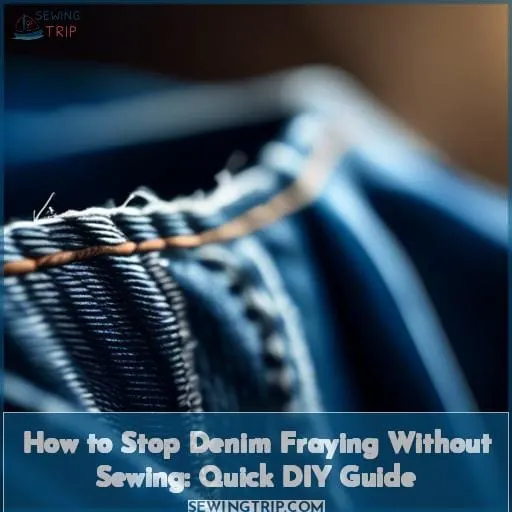 Facing frayed denim but lack sewing skills? Don’t fret.
Facing frayed denim but lack sewing skills? Don’t fret.
This guide empowers you to halt denim fraying with simple, non-sewing techniques. You’ll learn how to prepare, cut, and treat your jeans to maintain a polished look, using everyday items for fray prevention.
Master the art of keeping your denim sharp and intact, ensuring longevity and style without threading a needle. Embrace these savvy methods to keep your denim in pristine condition, no sewing required.
Table Of Contents
Key Takeaways
- Apply liquid seam sealants like Fray Check or Fray Block to bind fabric fibers and prevent fraying without sewing.
- Use clear nail polish to seal fabric edges, which is an inexpensive and effective method for fray prevention.
- Trim any overly long threads after cutting to maintain a clean edge and minimize further fraying.
- Wash jeans after applying fray prevention methods to initiate controlled fraying and monitor the hem for wear, reapplying products as necessary.
How to Stop Denim From Fraying Without Sewing

To stop denim from fraying without sewing, you can apply clear nail polish along the raw edges or use heat to seal the edges on synthetic fabrics.
Understanding Denim Fraying
Denim fraying is a common issue that arises from the natural wear and tear of the fabric, as well as from repeated washing.
To address this problem without sewing, you can apply a liquid seam sealant like Dritz Fray Check. This product is designed to prevent the edges of the fabric from fraying further by securing the threads in place.
It dries clear and can withstand washing and dry cleaning, making it a durable solution for most fabric types.
When using Fray Check, it’s important to follow the instructions carefully, apply it in a well-ventilated area, and test it on a scrap piece of fabric first to ensure it doesn’t adversely affect the color or texture of your denim.
Fraying as a Natural Result of Wear and Tear
Denim fraying is a natural consequence of the love and life you pour into your jeans.
But when your raw-hem jeans start looking like a shaggy dog, it’s time to take action. To keep your frays in check, you can give them a little trim—think of it as a quick denim haircut.
If they’re still partying too hard, sewing a line above the fray can be like setting a curfew, keeping the wild threads from staying out too late. And for those who’d rather not thread a needle, Fray Block is your new best friend.
It’s like a secret agent that keeps the fray from blowing its cover, all without making the fabric feel like cardboard. Remember, fraying may seem like a denim disaster, but with a few clever moves, you can keep your jeans looking intentionally chic rather than unintentionally shabby.
Impact of Washing on Fraying
Washing your jeans can indeed be a double-edged sword when it comes to fraying. On one hand, it’s the highway to achieving that coveted, lived-in look. On the other, it can lead to an overzealous frayed hem that looks like it’s been through a paper shredder.
To keep the fraying in check, consider preshrinking your jeans to avoid shrinkage surprises. Materials like fabric stabilizer, fabric glue, or even a dab of clear nail polish can act as a fray-fighting force field.
And if you’re feeling crafty, pinking shears can create a zigzag pattern that discourages fraying.
Pre-Cutting Preparations
Before you start transforming your jeans into a trendy raw-hem look, it’s crucial to pre-wash them to avoid any shrinkage issues later on.
You’ll also want to ensure the new length is just right by trying them on with various shoes and marking the desired hem.
Importance of Pre-washing Jeans
Before you take scissors to your denim, remember to pre-wash those jeans! This isn’t just busywork; it’s your secret weapon against shrinkage sabotage.
You want that hem to be spot-on, not creeping up your ankles after the first wash. Plus, pre-washing helps fade the fabric evenly, boosting the durability of your soon-to-be-cut hem.
So, iron on that hem tape or mark your length with precision—pre-washing sets the stage for a fray-free finale without a single stitch of sewing.
Marking the Correct Length
After pre-washing your jeans to avoid any shrinkage surprises, it’s crucial to nail the length before you make the cut.
- Measuring techniques: Grab a pair of jeans you love the length of and use them as your blueprint. Lay them on top of your DIY project jeans, aligning the inseams, to mark the perfect length.
- Chalk placement: If you’re going solo without a guide pair, wear your jeans and mark them with chalk or a safety pin at your desired length. Remember, it’s better to err on the side of too long than too short—you can always trim more later.
- Safety pin marking: For a temporary fix or to test out different lengths with various shoes, fold the hem to the inside and secure it with safety pins. This non-permanent adjustment allows you to play around with length without commitment.
Precision cutting and fabric alignment are your best friends here. A straight cut is essential for a clean look, and ensuring both legs are even is paramount. Don’t rush this step; a little patience goes a long way in achieving that professionally done appearance, even if it’s a DIY project.
Remember, mastering the art of the perfect jean length isn’t just about fashion; it’s about crafting a look that’s uniquely yours, with every snip and adjustment.
Cutting Techniques
When it comes to stopping denim from fraying without sewing, ensuring even pant leg lengths and making a straight cut for a clean edge are crucial steps.
To achieve even lengths, fold the jeans in half down the center, matching up both pant legs, and use the first cut leg as a guide to cut the second leg to the same length.
Cutting straight across ensures a clean edge, which is essential for a polished look and easier fraying control. These techniques are simple yet effective for customizing the length of your jeans while minimizing fraying.
Ensuring Even Pant Leg Lengths
After you’ve pre-washed and marked your jeans for the perfect length, ensuring both pant legs are even is your next crucial step.
This is where the art of pant folding, measuring accuracy, and pin marking come into play.
Similarly, achieving leg symmetry is foundational to your jeans’ final look. Use the initial trim as your guide, but don’t rush.
Straight Cutting for a Clean Edge
After ensuring your pant legs are even, it’s time to focus on achieving that clean, straight cut for your DIY raw hem.
Here’s where precision meets creativity. Grab those sharp scissors—think of them as your wand in this denim wizardry.
Imagine drawing a straight line across the sea; that’s how you want to approach the hem of your jeans. It’s a blend of art and science, where fabric selection plays a crucial role. Denim, with its sturdy character, is your canvas.
Trimming techniques are your brush strokes, and edge protection is your sealant against the tides of fraying.
Denim care post-trim is like nurturing a plant; it requires attention and patience. So, wield your scissors with confidence and let the transformation begin. Your jeans, your masterpiece, await.
Fray Prevention Methods
To prevent excessive fraying on raw-hem jeans, there are several methods you can employ without the need for sewing. One effective solution is to use a fabric seam sealant like Fray Check, which is a liquid adhesive that binds the fabric fibers together to resist fraying.
It’s suitable for various fabric types, including denim, and remains flexible after drying, which is important for maintaining the comfort and movement of the jeans. Fray Check is also clear when dry, so it won’t alter the appearance of your jeans.
Another option is Fray Block, which is similar to Fray Check but is known for drying quickly and leaving the fabric soft and flexible. It comes with an ultra-fine precision tip for easy application along the fabric edges.
For a DIY approach, you can also use clear nail polish to seal the edges of the fabric. This method involves applying a thin layer of nail polish along the cut edge of the denim to create a barrier that prevents fraying.
Before applying any product, it’s recommended to test it on a scrap piece of fabric or an inconspicuous area to ensure it doesn’t adversely affect the material. Additionally, always follow the manufacturer’s instructions for the best results and allow ample time for the product to dry before handling the jeans.
Alternative Household Items for Fray Prevention
Diving into fray prevention without a needle and thread? You’re in for a crafty adventure.
- Vinegar solution: A stitch in time saves nine, but a dip here saves a fray.
- Nail polish: Not just for nails, it seals threads with a glossy finish.
- Clear glue: The invisible hero, holding fibers together.
- Candle flame: Briefly dance the edge over the flame; it’s a delicate tango.
- Fabric glue: The stronghold in fabric battles, ensuring no fray strays.
Post-Cutting Care
After cutting your raw-hem jeans to the desired length, it’s important to manage the fraying to maintain a controlled, stylish look.
Washing your jeans can initiate a natural fraying process, giving you that trendy raw edge. However, to prevent excessive fraying over time, you can maintain the hem by trimming any overly long threads and applying a liquid seam sealant like Dritz Fray Check.
This product is designed to secure the fabric edges and thread ends, preventing further fraying while being durable through washes and dry cleaning.
Washing to Initiate Controlled Fraying
After you’ve given your jeans a new raw hem, it’s time to manage the fraying. While a bit of fraying adds character, you don’t want it to go overboard. To prevent excessive fraying and maintain the length accuracy of your DIY project, consider shrinkage prevention.
Before you even start cutting, make sure to wash and dry your jeans to address any potential fabric sensitivity and avoid future shrinkage that could mess with your length.
Once you’ve cut the first leg with precision, use it as a template for even cutting on the second leg. This ensures both hems are symmetrical and your jeans look intentionally styled, not like a hasty hack job.
If you’re not keen on sewing, there are alternative methods to keep the frays in check. Fray prevention products can be applied to the raw edges to seal the fibers. Just remember to test any product on a scrap of fabric first to ensure it doesn’t affect the denim’s color or texture.
With these steps, you’ll have a pair of perfectly frayed jeans that won’t unravel further, keeping your look chic and under control.
Maintenance of the Frayed Hem Over Time
To maintain the frayed hem of your jeans over time, you’ll want to keep an eye on fray progression and take action when necessary.
- Trim Stray Threads: Occasionally snip away any long, loose threads to keep the frayed edge neat.
- Monitor Hem Wear: Regularly check the hem for signs of excessive fraying that could compromise fabric durability.
- Fray Prevention: Apply a fray prevention product like Fray Block or Fray Check to minimize further unraveling and help with fade prevention.
Frequently Asked Questions (FAQs)
Can Fray Check be used on colored denim?
Yes, Fray Check can be used on colored denim. It’s a champ at halting frays in their tracks, securing those pesky thread ends without changing the color of your jeans.
Just remember, it might stiffen the fabric a bit, so apply it with a light hand.
How long does Fray Block take to dry?
Fray Block typically dries quickly, but the exact drying time can vary based on application amount and environmental conditions.
It’s wise to allow it to set for a few hours to ensure it’s fully dry.
Is Fray Block suitable for delicate fabrics?
Yes, Fray Block is suitable for delicate fabrics. It’s designed to prevent fraying without leaving the fabric stiff or discolored, making it a great choice for those fragile materials you’re working with.
Can Fray Check be applied to already frayed hems?
Yes, Fray Check can be applied to already frayed hems to prevent further fraying.
It’s a savvy move to keep those trendy jeans in check without reaching for a needle and thread.
Does Fray Block have a strong odor when applied?
Fray Block does have a scent, but it’s like a ninja—there one second, gone the next.
So, while it might make its presence known initially, it won’t linger to offend your olfactory senses.
Conclusion
Sailing through the sea of denim care, you’ve now armed yourself with the knowledge to combat the fraying tides without ever picking up a needle.
By understanding the natural wear and tear of denim and employing strategic pre-cutting preparations and cutting techniques, you’ve set the stage for fray prevention.
Utilizing household items for fray prevention not only showcases your ingenuity but also ensures your denim remains in shipshape.
Embrace these no-sew methods to stop denim from fraying, and watch your denim’s lifespan and style quotient soar.

